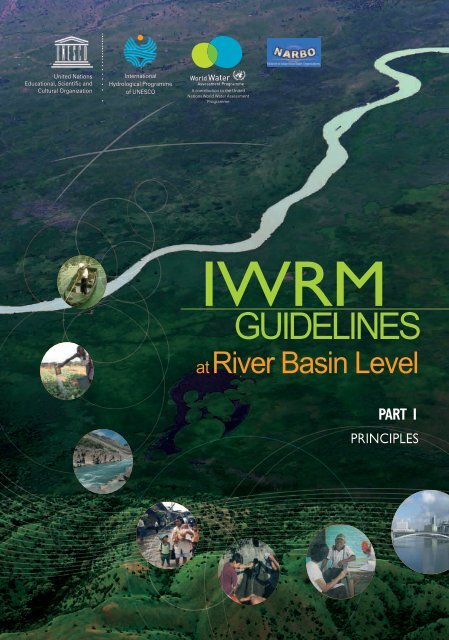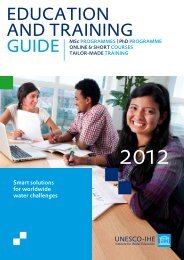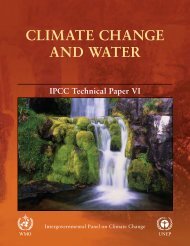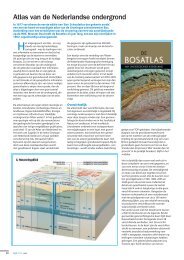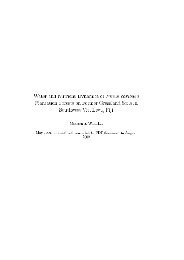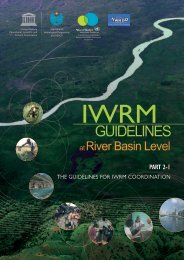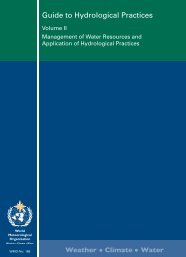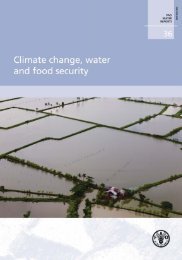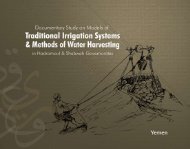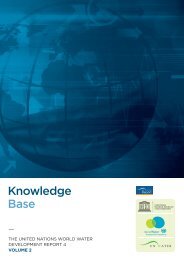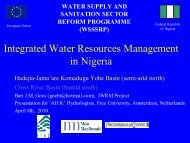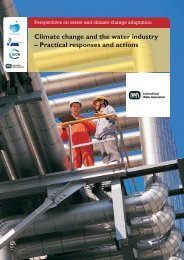Part 1 Principles - Unesco
Part 1 Principles - Unesco
Part 1 Principles - Unesco
- No tags were found...
Create successful ePaper yourself
Turn your PDF publications into a flip-book with our unique Google optimized e-Paper software.
United NationsEducational, Scientific andCultural Organization.............. . . . . .InternationalHydrological Programmeof UNESCOA contribution to the UnitedNations World Water AssessmentProgrammeIWRMGUIDELINESat River Basin LevelPART 1PRINCIPLES
FOREWORDby Mr Koïchiro Matsuura,Director-General of UNESCOWater is fundamental for sustainable development. It affects inter alia sanitation, health, povertyalleviation, disaster reduction, and ecosystem conservation, and cuts across all eight MillenniumDevelopment Goals, in particular MDG 7 and its target to reduce, by half, the proportion of the 2.6billion people without access to safe drinking water and basic sanitation by 2015. In addition, the evergrowing vulnerability that is induced by global and local changes such as population changes, climatechanges and variability, socio-economic issues and environmental degradation, can result in increasingboth the frequency and severity of extreme events, including droughts and floods.Integrated Water Resources Management (IWRM) can play a key role in addressing these needsand challenges. However, progress towards implementing IWRM has so far varied widelydepending on the area, capacity, political will, and understanding of IWRM concepts and theirimplementation.Implementing IWRM at the river basin level is an essential element to managing water resourcesmore sustainably, leading to long-term social, economic and environmental benefits. Becausewater is managed locally, a river basin approach provides a practical framework, defined bygeographical and hydrological characteristics, which facilitates implementation of IWRM byinvolving downstream and upstream basin wide issues as well as incorporating environmentaland socio-economic aspects.To this end, UNESCOʼs International Hydrological Programme (IHP), following the issuance of its2007–2008 review report titled ʻIWRM Implementation in Basins, Sub-basins and Aquifers: Stateof the Art Reviewʼ realized the need for an instruction manual that synthesizes practical methodologiesfor IWRM at the river basin level. These Guidelines are a follow up to the review, and are also acontribution towards the World Water Assessment Programme (WWAP), which is currently launchingthe third United Nations World Water Development Report (WWDR–3). They are meant to bea living document – users are therefore invited to use these materials interactively with the projectteam, and contribute to its improvement with suggestions on methodology as well as by introducingnew case studies.I sincerely hope that these Guidelines will assist water practitioners in finding better and more efficientsolutions to day-to-day problems, as well as play a catalytic role in promoting holistic integrated actionsamongst all water practitioners, ultimately leading to more sustainable societies.I would like to acknowledge, with thanks, the support of Steering Committee members and partnerorganizations in the production of these Guidelines. My special thanks go to the Government of Japanfor its dedicated support throughout the implementation of the project.Koïchiro MatsuuraiiIWRM Guidelines at River Basin Level – <strong>Part</strong> 1: <strong>Principles</strong>
MESSAGE TO THE USERSWhat is integrated water resources management(IWRM)? It is a step-by-step process of managingwater resources in a harmonious and environmentallysustainable way by gradually uniting stakeholdersand involving them in planning and decisionmakingprocesses, while accounting for evolvingsocial demands due to such changes as populationgrowth, rising demand for environmental conservation,changes in perspectives of the cultural and economicvalue of water, and climate change. It is anopen-ended process that evolves in a spiral mannerover time as one moves towards more coordinatedwater resources management.Why is IWRM needed? Water is a limited resourcethat is essential for economic growth and environmentaland social well-being. Because it affects everyone,managing this precious resource requires balancingthe interests of the many different user groups andindividuals. Without that balance many conflicts canoccur. Promoting coordinated water resources managementin a basin that is open to all stakeholderswill not only resolve such conflicts but will also bringenormous benefits to society, the basin, and to individualstakeholders.The principles and concepts of IWRM havebeen widely recognized, but the implementationof IWRM is not satisfactorily progressing in manybasins. This is, perhaps, because the practitionersresponsible for water resources management at thebasin level encounter difficulties in understandingwhere and how to begin, or the advantages ofapplying IWRM with respect to their actual situationmay not be apparent enough. On the otherhand, policy makersʼ dedicated approaches for settingup enabling environments and political frameworksthat strongly support sound and sustainablewater resources management are necessary prerequisitesfor IWRM to function effectively. Therefore,it is desired that practitioners and decision makersabsorb the ideas and needs of IWRM, and understandthe effectiveness of applying these within abasin-wide approach. UNESCO realised that therewas a need for a mechanism to translate the IWRMprinciples into practical applications. These Guidelinesfor IWRM at River Basin Level are intended tobe used for that purpose, as a tool to fill that ʻgapʼ.To get started with IWRM, you need to identify thefull spectrum of stakeholders involved in river basinmanagement issues. It is important to have a goodunderstanding of how other stakeholders relate towater, and how they are related to you through water.As a practitioner involved in IWRM in your basin,you will probably face difficulties and challenges.Conflicts of interest and opinions among stakeholdersmay make coordination extremely difficult. In order toovercome such situations, you need a set of ʼkeysʼ toadvance IWRM in your basin. Knowing which kindsof ʼkeysʼ have been used in other basins will allow youto create a ʼkeyʼ suitable for your situation.These Guidelines provide you with the necessaryinformation to help you implement IWRM under yourown circumstances. They consist of the fundamentalconcepts of IWRM as well as perspectives of variousstakeholders with regard to water issues, keys for successfor overcoming problems, and good exampleswhere such keys for success were applied. IWRMcannot be accomplished in isolation. Think of IWRMas a user-friendly and cooperative approach that isan alternative to the previous activities of individualwater using sectors acting in their own interests, withvery little interaction with one another. The Guidelinesinvite each sector to fruitful participation andcooperation in IWRM, with a practical road map soas to contribute to achieving both private and publicbenefits in a sustainable manner.IWRM is a process that evolves continuously overtime – principles change, as do technologies and procedures.You cannot do everything at once. Set goalsthat are achievable within the given timeframe, andstart with what you have. Enhance your IWRM expertiseby revisiting your experience in the light of thekeys for success presented in these Guidelines. Conveyyour knowledge and wisdom to other practitionersas well as to younger generations. If you face challengingsituations in the frontline of the IWRM implementation,refer to these Guidelines once again, andfind your own Key for Success.Co-Chairs of the Steering CommitteeIWRM Guidelines at River Basin LevelEugene Z. StakhivShinsuke OtaIWRM Guidelines at River Basin Level – <strong>Part</strong> 1: <strong>Principles</strong>iii
ACKNOWLEDGEMENTSThe Guidelines have been written as a contributionto the World Water Assessment Programme(WWAP), presently launching thethird United Nations World Water DevelopmentReport (WWDR–3). Many individualsand organizations from around the world havecontributed to the Guidelines. We would liketo thank in particular the Japanese Ministryof Land, Infrastructure, Transport and Tourism,and the Japan Water Agency for their substantialcontributions to the project. The Guidelinesare a work in progress, and will be up-datedcontinuously so as to increase and retain itsutility for all users.UNESCO acknowledges that GWP/INBO isalso producing an IWRM handbook focused onbasins. UNESCO and GWP/INBO have beenactively coordinating their efforts so that theGuidelines and the GWP/INBO handbookcomplement each other. The Handbook highlightsthe creation of an ‘enabling’ institutionalframework that promotes key IWRM principlesthrough policy guidance, legislation and a wellfunctioningregulatory framework. These Guidelines,on the other hand, describe an approachto introducing IWRM at the river basin levelthat begins with implementing currently availablemeasures in the context of existing institutionsand resources, and as capacity grows,evolving towards a fully integrated approachtowards the provision of multi-sectoral waterservices.Members for the preparation of the GuidelinesSteering Committee Members of the GuidelinesProjectCo-chairsEugene Z. Stakhiv (International Center for IntegratedWater Resources Management, ICIWaRM)Shinsuke Ota (Japan Water Agency, JWA)MembersAdnan Altay Altinörs (Deputy Directorate General forEnergy, Water and Environment; Ministry of ForeignAffairs, Turkey)András Szöllösi-Nagy (UNESCO)Kenzo Hiroki (Ministry of Land, Infrastructure, Transportand Tourism, MLIT, Japan)Kuniyoshi Takeuchi (International Centre for WaterHazard and Risk Management, ICHARM)Mochammad Amron (Network of Asian River BasinOrganizations, NARBO)Reza Ardakanian (UN – Water Decade Programme onCapacity Development; UNW-DPC)Shahbaz Khan (UNESCO-IHP)Shelley McMillan (World Bank, WB)Tony Jakeman (Integrated Catchment Assessment andManagement Centre, iCAM, The Australian NationalUniversity, Australia)Victor Pochat (Universidad Nacional del Litoral,Argentine)Wouter Lincklaen Arriens (Asian Development Bank,ADB)External ContributorsReviewer, William CosgroveReviewer, Richard F. ConnorEditor, David McDonaldEditor, Cathy LeeDesigner, typography and layout, Eric LoddéSecretariatToshihiro Sonoda (UNESCO)Natsumi Okamine (UNESCO)Mao Takeuchi (UNESCO)The Guidelines can be downloaded from the UNESCOwebsite (http://www.unesco.org/water/)ivIWRM Guidelines at River Basin Level – <strong>Part</strong> 1: <strong>Principles</strong>
STRUCTURE OF THE GUIDELINESThe Guidelines consist of two parts.<strong>Part</strong> 1 deals with the Overarching <strong>Principles</strong> of IWRM at River Basin Level.<strong>Part</strong> 2 deals with practical examples intended for use by practitioners of IWRM.<strong>Part</strong> 1 provides basic principles of IWRM mainly targeting policy-makers, and explains thebenefits of IWRM at river basin level and the need to promote it at the policy level. It alsoproposes a spiral model of IWRM, which illustrates the evolving and dynamic nature of theIWRM process.<strong>Part</strong> 2 consists of three sub-parts:• <strong>Part</strong> 2-1 The Guidelines for IWRM Coordination• <strong>Part</strong> 2-2 The Guidelines for Flood Management• <strong>Part</strong> 2-3 Invitation to IWRM for Irrigation Practitioners<strong>Part</strong> 2-1 and <strong>Part</strong> 2-2 are compiled from the point of view of comprehensive coordination ofIWRM at the basin level. <strong>Part</strong> 2-3 is prepared from the perspective of irrigation practitionersas representatives of water users. This document invites them to actively participate in IWRM.Hence, the document is entitled ‘Invitation to IWRM’.Two main features of the Guidelines are the Sector Perspectives and the ‘Key for Success’.Sector Perspectives provide insights on what individual sectors are typically thinking. What isdescribed in this section may not be complete, but the important thing is to know how othersectors perceive water management and how they are related to IWRM.The core of <strong>Part</strong> 2 is the keys for success, which can be used in practice to help IWRM succeedat the basin level. Some of the keys for success are extracted from good examples of IWRMimplementation in several different river basins worldwide.IWRM Guidelines at River Basin Level – <strong>Part</strong> 1: <strong>Principles</strong>v
MESSAGE TO THE USERSTABLE OF CONTENTSForeword .............................................................. iiMessage to the Users ......................................... iiiAcknowledgements ............................................ ivStructure of the Guidelines ................................ v1. Introduction ................................11.1 Background ....................................................11.2. Status of IWRM Implementation ................22. Benefits of IntegratedWater Resources Managementat the River Basin Level ..................... 42.1. The river basin as an appropriateunit for integrated management ....................... 42.2. Interactions between the riverbasin approach and differentadministrative levels ........................................... 62.3. All sectors benefit from IWRMat the river basin level ....................................... 73. IWRM as an EvolutionaryProcess at the River Basin Level .... 83.1. The spiral model for conceptualizingthe evolutionary IWRM process ....................... 83.2. Reassessment of basin hydrology ............ 103.3. Adapting management plansto changes ......................................................... 113.4. Climate change as an uncertaindriver ................................................................. 113.5. Addressing urbanization andland-use change ................................................. 123.6. Recognizing the evolving roleof agriculture ..................................................... 124. The ImplementationProcess ......................................... 134.1. Embarking on IWRM in a basin ................ 134.2. Important conditions ................................ 144.3. River basin organizations .......................... 174.4. Transboundary issues ................................ 185. Enhancing Performanceand Accountability ...................... 195.1. Reporting .................................................... 195.2. Knowledge networks ................................ 195.3. Performance indicatorsand benchmarking ............................................. 195.4. Adaptive management basedon assessment results ...................................... 206. Organization of <strong>Part</strong> 2 ............ 216.1. Features ...................................................... 216.2. Contents ..................................................... 21Bibliography ....................................................... 23viIWRM Guidelines at River Basin Level – <strong>Part</strong> 1: <strong>Principles</strong>
1. IntroductionKEY MESSAGESWater is important for sustainable development (1.1)IWRM at the river basin level is a process that leads to water security and helps mitigatewater-related risks (1.1)1.1 BACKGROUNDWater is important for developmentSound management of water resources isfundamental for sustainable development.Good water cycle management is vital forgrowth, social and economic development,poverty reduction and equity – all of whichare essential to the achievement of the MillenniumDevelopment Goals.The emerging concept of IWRMIntegrated Water Resources Management(IWRM) emerged around the 1980s inresponse to increasing pressures on waterresources from competition amongstvarious users for a limited resource, therecognition of ecosystem requirements,pollution and the risk of declining wateravailability due to climate change. A centralgoal of IWRM at the river basin level is toachieve water security (1) for all purposes,as well as manage risks while responding to,and mitigating, disasters. The path towardswater security requires resolving tradeoffsto maintain a proper balance betweenmeeting various sectors’ needs, and establishingadaptable governance mechanismsto cope with evolving environmental, economicaland social circumstances. IWRMstrives for effective and reliable delivery ofwater services by coordinating and balancingthe various water-using sectors – thisis an important part of sustainable watermanagement. As water is mainly managedlocally, the river basin approach is recognizedas a comprehensive process for managingwater resources in a more sustainablemanner. However, well-developed, welltested,scientifically robust, socially accept-1. Further definitions of ‘water security’:(1) ‘water security’ is the reliable availability of an acceptable quantityand quality of water for production, livelihoods and health, coupled withan acceptable level of risk to society of unpredictable water-relatedimpacts.’ (Mexico City, 2006. Water for Growth and Development. ATheme Document of the 4th World Water Forum, World Bank).(2) Water security is the capacity to provide sufficient and sustainablequantity and quality of water for all types of water servicesand protect society and the environment from water-related disasters.(Tunis, 28 January , 2008,-African Ministers’ Council on Water(AMCOW) and the African Development Bank (AfDB).IWRM Guidelines at River Basin Level – <strong>Part</strong> 1: <strong>Principles</strong>1
INTRODUCTIONable and economically viable approaches toimplement IWRM at the river basin levelare still not widely available.The relationship between IntegratedWater Resource Management (IWRM)and Integrated River Basin ManagementThe term ‘Integrated River Basin Management’,as used in these Guidelines, is referredto in the context of implementing IWRM forthe provision of water services at the riverbasin level. IWRM is defined by the GlobalWater <strong>Part</strong>nership (GWP) as ‘a processwhich promotes the coordinated developmentand the management of water, land andrelated resources, in order to maximize theresultant economic and social welfare in anequitable manner without compromising thesustainability of vital ecosystems’. It is a holisticapproach that seeks to integrate the managementof the physical environment within thatof the broader socio-economic and politicalframework. The river basin approach seeksto focus on implementing IWRM principleson the basis of better coordination amongstoperating and water management entitieswithin a river basin, with a focus on allocatingand delivering reliable water-dependent servicesin an equitable manner.Purpose of these GuidelinesThe purpose of developing these Guidelinesis to facilitate the practical implementationof IWRM at the river basin level, relying onavailable resources – by making the existingsystem work more effectively. These Guidelineswill also help raise international awarenessof IWRM.1.2 STATUS OF IWRMIMPLEMENTATIONHistory of IWRMAn early example of an integrated approachtook place in the 1930s in the United Statesof America (USA), with the development ofcomprehensive watershed plans for naturalresource usage (e.g. Tennessee Valley Authority).Since then, the UN and other internationalorganizations have developed differentforms of integration under the IWRM concept,which has evolved over the decades.IWRM has remained an important conceptfor water management since the Agenda 21process of the United Nations Conferenceon Environment and Development (UNCED)in Rio de Janeiro in 1992. Its profile has beenraised through more recent global pronouncementssuch as the World Summit onSustainable Development (WSSD) in 2002,where the target to ‘develop integratedwater resources management (IWRM) andwater efficiency plans by 2005, throughactions at all levels’ was agreed through theJohannesburg Plan of Implementation (JPOI)with support to developing countries.Status of IWRM implementationExperience in various countries has shownthat IWRM is an essential prerequisite foreffectively coordinating water developmentstrategies across diverse sectors, politicaljurisdictions and geographical regions withina river basin. However, progress towardsimplementing IWRM in developed and developingcountries has varied widely. Accordingto a recent UN-Water Status Report (2) , lackof progress is characteristically associated2. Status Report on Integrated Water Resources Managementand Water Efficiency Plans (CSD16), UN-Water 2008.2 IWRM Guidelines at River Basin Level – <strong>Part</strong> 1: <strong>Principles</strong>
with the need to improve public awarenessamongst the hierarchy of political jurisdictionsand overlapping management institutions.In developing countries, progress canbe hindered by additional obstacles related tothe region, such as technical capacity, politicalwill and understanding of IWRM conceptsand implementation. The Status Report alsorevealed the existence of diverse interpretationsamong countries of IWRM planning andmanagement processes and their frameworks.These differences may even exist within onecountry or between different stretches orsub-basins of the same river.Global enhancement of IWRM at theriver basin levelUNESCO’s International Hydrological Programme(UNESCO-IHP) declared in its latestprogramme report that there is a needfor an instruction manual that synthesizespractical methodologies for Integrated RiverBasin Management to help implement IWRM.The application of IWRM principles at theriver basin, watershed, lake basin or aquiferscales of management is also increasinglyaccepted worldwide as the way to overcomethe considerable challenges in implementingIWRM. Although an ‘enabling’ institutionalinfrastructure is a desirable prerequisite forimplementing IWRM, it is not enough for thepractical execution of effective water management– that is, for the efficient and reliabledelivery of water-dependent servicessuch as hydropower, municipal and industrialwater supply and irrigated agriculture, oreven environmental flows and flood damagereduction. It is at the river basin scale thatcooperation schemes, wide-ranging effortssuch as coordination, collaboration and jointaction are currently implemented. In somecases, cooperation has resulted in the establishmentof standing institutional structuresthrough which governments can interactregularly. However, institutional arrangementsto facilitate a fully implemented IWRMapproach at a basin level have not emerged,primarily because the concept is complexand requires a very high level of commitmentand follow-through. Tools for IWRMneed to be documented in the context ofthe existing and emerging human capacityin basins, taking into consideration whetherriver basin organizations are involved in theformal coordination processes.IWRM Guidelines at River Basin Level – <strong>Part</strong> 1: <strong>Principles</strong>3
BENEFITS OF IWRM2. Benefits of Integrated WaterResources Management at theRiver Basin LevelKEY MESSAGESThe river basin is an appropriate unit for integrated management (2.1)IWRM can effectively deliver a triple bottom line of economic efficiency, social equity andenvironmental sustainability that are essential for sustainable development (2.1)Applying IWRM enables appropriate inclusion of water-related disaster management andalleviation of environmental impacts (2.1)The importance of water should be recognized at the highest level of decision-making aswell as at the basin level (2.2)Each sector benefits by participating in IWRM (2.3)IWRM is the foundation for progressing adaptation to climate change (2.1)2.1 THE RIVER BASIN ASAN APPROPRIATE UNIT FORINTEGRATED MANAGEMENTA basin-level perspective enables integrationof downstream and upstream issues, quantityand quality, surface water and groundwater,and land use and water resources in a practicalmanner.Water is recognized as essential for social,economic and environmental development.Management within a basin unit enables theintegration of all-important environmentaland socio-economic issues into evolvingmanagement plans and complementaryregulatory decisions. A basin-level perspective,defined by geographical and hydrologicalcharacteristics, facilitates the practical integrationof downstream and upstream as wellas basin-wide issues, and the incorporationof quantity and quality aspects of the basin’savailable surface and groundwater resources.Cumulative land-uses in a river basin, suchas urban development, agriculture and forestconservation, can have profound impactson water resources in the basin and viceversa. A basin-level perspective allows watermanagers to address the linkages betweenwater resources management and the managementof land and other related resources4 IWRM Guidelines at River Basin Level – <strong>Part</strong> 1: <strong>Principles</strong>
effectively. Sustainable development shouldreflect national development objectives andplans, as well as those of local governmentalunits and management agencies. IWRM providesthe institutional and intellectual infrastructurethat allows the numerous competinggoals and objectives to be coordinatedand administered in a coherent and uniformmanner.Benefits for adaptation to climatechangeA basin level perspective also becomesincreasingly important in addressing globaland local change issues, particularly as climatechange impacts are realized throughthe response of the hydrological cycle, interms of quality and quantity with directimpacts on the basin. Such changes mayinclude increases in the number and severityof floods and droughts over current seasonalpatterns. Climate change is the supply-sidedriver, which ultimately determines howmuch water is available, when and where –and ultimately how much we can use. It canlower environmental flows in rivers, affectingwater availability, quality and other waterfunctions such as sanitation, hydropower andnavigation. Climate change may not alwaysbe perceived as the fundamental water challengein every region, but it may exacerbateexisting management challenges. In order toreasonably mitigate these anticipated climateimpacts, it is even more essential to coordinatea variety of existing water managementpractices in a basin across all relevantsectors, and optimize operation of waterinfrastructure consistent with sustainabledevelopment goals and availability of water.Accordingly, IWRM at the river basin levelis the foundation upon which the implementationof adaptation strategies, based on asequence of climate change projections, andimpact assessments can be realized.Integrated management of waterresources, disasters and environmentalissuesThe management of water-related disasterssuch as floods and droughts, including properrisk management, should not be consideredin isolation, and should comprise an essentialpart of IWRM. Managing the extremes inthe hydrologic cycle comprises the essenceof water resources management, as theseevents can have severe social and economicconsequences on development. Improvedmanagement of extremes can produce highrates of return in terms of GDP (GrossDomestic Product), maintaining economicgrowth and social cohesion.Proper management of water resourcesoffers increased flexibility in facilitating andsupporting natural ecological functions andhuman activities by improving the resilienceand robustness of those systems under avariety of stresses, including climate change.The seasonal and annual variability in qualityand quantity of water that supports thesediverse functions can be estimated throughmonitoring, analysis and assessment, thereafterincorporated into planning and operations.For example, operating rules for damscontrolling storage facilities for flood control,municipal water supply and hydropowercan be periodically modified to maximizetheir utility, while at the same time ensuringenvironmental flows. Thus, IWRM appliedat the river basin level enables appropriateinclusion of water-related disaster and riskmanagement as well as alleviating potentialenvironmental impacts.IWRM Guidelines at River Basin Level – <strong>Part</strong> 1: <strong>Principles</strong>5
BENEFITS OF IWRM2.2 INTERACTIONS BETWEENTHE RIVER BASIN APPROACHAND DIFFERENT ADMINISTRA-TIVE LEVELSMultiple objective water managementFood security, gender, health, environment,industry and many other objectives areclosely related to sound water resourcesmanagement. Water managers, especiallythose in developing nations, constantly facethe question of how these challenges ofproviding for diverse and competing needs,in the face of increasing scarcity and climatevariability, can be successfully addressedin a socially acceptable and economicallyefficientmanner, within the resource constraintsof their respective systems. Consultationwith stakeholders on their needsand objectives is a necessary and continuousprocess. Maintaining this ongoing publicconsultative process is a fundamental aspectof the evolution of the IWRM process asproposed in these Guidelines. The publicparticipation process reinforces the acceptabilityof IWRM as the foundation approachto water management that can create ownershipand resolution of issues among allstakeholders.Need for awareness at the highestlevelsCurrently, not all nations devote the requisiteattention to ‘governance’ of waterrelatedissues at national levels and linktheir national strategies to planning andmanagement of water resources at a basinscale. Therefore, the importance of waterresources for development and managementat a basin level should be recognizedat the highest national, regional and locallevels. Where the river basin has one ormore international borders, providingacceptable trade-offs among competingmanagement objectives from a neutralviewpoint becomes an increasingly timeconsumingchallenge.Responsibilities and roles of differentadministrative levels and functionsIdeally, the implementation of waterresources management and basin level planningshould be linked to national strategiesand policies that explicitly link the variouslevels of governmental and private sectordecision-making. Basin level water resourcesmanagement should coincide with a national‘vision’ and principles for sustainable development,but also reflect basin-specific issuesin its management plans and implementation,involving basin-wide stakeholders in anappropriate manner.A key aspect of IWRM requires that thenational government(s) create an enablingenvironment, including a legal framework,to facilitate a multi-sectoral coordinatedbasin-level approach. Thus, there will needto be linkages and coordination amongstthe national, regional, local and basin levels.The responsibilities of the different levelsof administration and relevant stakeholdersand their relationships and roleswithin the river basin management needto be clearly defined. A well-drawn relationshipdiagram provides a foundation tomaximize each party’s potential role, generatea synergistic effect, enable a flexibleapproach and improve efficiency in everyaspect of water resource management. Theprinciple of ‘subsidiarity’, however, requiresthat the implementation of projects andoperation of water functions need to bethe responsibility of the appropriate institutionor organization in the basin, which6 IWRM Guidelines at River Basin Level – <strong>Part</strong> 1: <strong>Principles</strong>
is empowered to manage the tasks and hasthe authority to influence policy, keeping inmind that the basin is the appropriate frameof reference for water resources management.In fact, few nations have establishedan ‘ideal’ vertical IWRM hierarchy wherenational policies and management strategiesare fully developed and coordinatedfor all aspects of water management atall levels of government. The principles ofIWRM can be implemented at virtually anyentry point in the vertical water managementhierarchy, consistent with the principlesof ‘subsidiarity’. These Guidelinesfundamentally advocate that the ideal of aperfect IWRM system does not exist – itis difficult to implement – yet needs to beinitiated with whatever resources are availableand whatever institutional frameworkexists. Sound water management improvesimperfect policies and makes them workbetter to deliver vital services.2.3 ALL SECTORS BENEFITFROM IWRM AT THE RIVERBASIN LEVELWhy participate in an IWRM process?Awareness of IWRM is partly the result ofthe realization that, until the 1990s – andstill today in some countries – infrequentinteraction between individual sectoralactivities, such as agricultural irrigation,flood control, hydropower, etc., resultedin sectors having little effective coordination.Another failing of such a fragmentedapproach was the insufficient focus onnational sustainable development as wellas IWRM. The first step on the path tointegration requires that each sector hasaccess to all the compiled basin data,updated information, as well as the abilityof avoiding unexpected risks causedby uncoordinated internal and/or externalsector activities. Moreover, the processesinherent in achieving basin sustainabilityneed to be undertaken through a series ofurgent actions, coupled with flexible measuresand mutual coordination, along withstakeholder participation.IWRM Guidelines at River Basin Level – <strong>Part</strong> 1: <strong>Principles</strong>7
IWRM IS AN EVOLUTIONARY PROCESS3. IWRM is an Evolutionary Processat the River Basin LevelKEY MESSAGESIWRM is an iterative, evolutionary and adaptive process, conceptualized as a ‘spiral’,which permits immediate action, builds understanding, develops local capacity and createsownership (3.1)Reassessment of basin hydrology improves understanding of a changing water cycle(3.2)Drivers of change at the basin level should be recognized and prioritized for adaptation(3.3)Reassessment for adaptation to changes can be an opportunity to consider and addressspecial drivers such as climate, land-use changes and the agricultural footprint in theevolving IWRM process (3.4 to 3.6)3.1 THE SPIRAL MODEL FORCONCEPTUALIZING THE EVOL-UTIONARY IWRM PROCESSThe conceptual spiral model of IWRMplanningThe evolutionary, adaptive implementationof the IWRM process presented in theseGuidelines is illustrated by a ‘spiral model’.In this model, water resources developmentin a basin, along with management principlesand objectives, evolves over time, asnew demands and needs emerge, and innovativesolutions are added at each stage. Ariver basin continuously adapts to thosedemands as part of an orderly IWRM process.This is facilitated by agreements amongbasin stakeholders on the necessary tradeoffsat each turn of the evolutionary watermanagement spiral. The ‘spiral model’ (SeeFig. 3.1) is a convenient graphical conceptualizationof the iterative, evolutionary adaptivemanagement process, adjusting to newneeds, circumstances and societal goals. Thespiral evolutionary model reflects progressivepositive changes in historical waterresources development and managementand offers the following advantages:8 IWRM Guidelines at River Basin Level – <strong>Part</strong> 1: <strong>Principles</strong>
• It allows IWRM actions to be started at anypoint of the evolutionary process.• It builds capacity over time.• It promotes cooperation and integration.• It promotes the pursuit of better solutionsthat adapt to changing circumstances andvalues.• It facilitates consensus building and stakeholderownership at each ‘turn of the spiral’.• It illustrates IWRM as an incremental, stepby-stepprocess, and therefore provides apractical framework for looking ahead andplanning for successive ‘turns of the spiral’.IWRM at the river basin level seeks improvementsin existing and conventional approachesto water resources management leadingtowards the ultimate goal of sustainable development.There are certain evolutionary developmentprocesses that are characteristic ofevery river basin – moving from a focus oneconomic development to community safetyand environmental protection, and to reliabledelivery of services and integrated resourcemanagement. Every major flood, drought orfailure of an infrastructure system designed toprovide a certain level of safety and reliabilityof services, serves as an opportunity to introducenew policies, programmes, projects andtechnologies that are more compatible withIWRM for sustainable development. This maybe in the form of introducing a new watershedmanagement unit; an equitable water allocationagreement that includes provisions forenvironmental flows; or a drought contingencymanagement process.In fact there are two inter-twined spirals– almost equivalent to a ‘double helix’: onerepresenting the historical evolution of waterresources development in a basin, and theother reflecting the specific point in the spiralin which new planning processes are institutedto represent updated IWRM principles.The planning process, also linked to the ‘spiral’,requires several stages over time to achieveone full circle of the IWRM planning andimplementation system. This spiral planningprocess begins with ‘Recognizing/Identifying’pressing issues or needs, then ‘Conceptualizing’the problem itself and formulating possiblesolutions, ‘Coordination and Planning’ amongstakeholders in order to reach an agreement,and ‘Implementing/Monitoring/Evaluating’ theplan and its outcomes. The iterative processthen begins again with ‘Recognizing/Identifying’at the next stage of evolution, incorporatingever-changing ideas, values and technologies,thereby responding to new needs.Every basin has a similar evolutionary spiral,some, like those of the Nile, Tigris and Euphrates,stretch back over thousands of years.Water resources development and managementis among civilization’s oldest publiclymanagedenterprises, and in many instancesserved as the ‘governance’ model aroundFig. 3.1 IWRM Spiral and ProcessIWRM Guidelines at River Basin Level – <strong>Part</strong> 1: <strong>Principles</strong>9
IWRM IS AN EVOLUTIONARY PROCESSwhich other public service activities wereconducted. Delivery of reliable water supplyto irrigated agriculture was a priority serviceof ancient civilizations. It is only over the pastthirty years that the principles of water managementhave been adapted to respond toincreased societal awareness about the environment,and cultural (e.g. the role of womenin water management) and socio-economicchanges, in other words, the fundament ofsustainable development. IWRM is the managementframework by which those goalsassociated with sustainable development canbe attained.Stages of IWRM spiral planningThe first stage of the ‘spiral’ begins with‘Recognizing/Identifying’ a need to adoptIWRM. At this stage it is important to graspthe overall picture of the basin and startwith already compiled information. The secondstage would commence as a result ofreviewing the current IWRM system or realizingdemand for completely new IWRM.Advanced stages tend to require more complexor broader coordination in accordancewith the growing concerns of stakeholders,socio-economic needs and priorities.Moving up the spiralShifts upwards on the spiral represent periodswhen a need for renewal or revision ofIWRM has been ‘identified’. Water managersshould therefore remain alert to the evolvingIWRM need to respond to changes in a basin.Changes in a basin may include economicgrowth, changing social values and demand,and unexpected crises, all of which wouldact as catalysts highlighting the necessity ofdeveloping or revising water resources management.Such changes should be consideredas a driving force for better water resourcesmanagement and a valuable opportunity toenhance IWRM. Consensus building is timeconsumingbut is facilitated by making an earlystart on the requisite actions. Information onsimilar cases in diverse areas may help foreseenecessary changes and demands on IWRM.Where does a basin stand on the spiral?An important aspect of the spiral planningmodel is understanding where the basin issituated on the spiral. What phase are theactors in? Are they in the phase of ‘recognizing’changes or ‘conceptualizing’? Howmany stages have already been accomplishedin the IWRM spiral? It is recommended thatwater managers analyse the situation of theirbasin to establish approximately its currentposition in the spiral before undertaking anyaction. <strong>Part</strong> 2 of these Guidelines is designedto cover most stages, phases and steps byproviding examples from a number of basins.Any basin management can therefore restartits own IWRM by orienting itself to the nearestposition in the ‘spiral’, which then hasdirect links to useful advice for the next step.If there seem not to be similar conditionsor appropriate solutions, it is recommendedthat users refer back to earlier sections ofthe Guidelines.3.2 REASSESSMENT OF BASINHYDROLOGYAdapting management plans designed torespond to changes at river basin levelrequires a sound understanding of the presenthydrological cycle, and the range of humanactivities affected by and affecting the hydrologicalcycle, and the cultures dependenton the resources of the basin. The internalhydrology of a basin can be reassessed forwater quantity, quality, and reliability, socialchange, water demand and the state of theecosystems, and the relation between the10 IWRM Guidelines at River Basin Level – <strong>Part</strong> 1: <strong>Principles</strong>
esponses to external drivers. Reassessmentalso involves reviewing current capacity tomitigate or adapt to changes including climatechange. Review of the potential capacityof a basin can include a review of historicaldata and information as well as traditionalknowledge. All local stakeholders should beinvolved in the process. This reassessmentprovides an opportunity to address otherissues that should be involved in the entireprocess of IWRM.3.3 ADAPTING MANAGEMENTPLANS TO CHANGESDrivers of changeWater resource systems are directly and indirectlyaffected by the interaction of numeroushuman related drivers of economic,social, and demographic functions such as:• Governance (institution, legal framework,decentralization).• Demography (population growth, gender,migration, urbanization).• Land use (agriculture, urbanization, deforestation,pavement).• Economy (industrialization, globalization,food and fuel crises).• Social conditions (education, culture, poverty).• Technology (water use technologies, informationtechnology, energy transformationtechnology).• Climate change and variability.Water managers should understand how differentdrivers of change affect the hydrologyand the related water demands and functionsto the inhabitants in the basin. Prioritizingadaptation responses to those changesis a key component of the IWRM process atthe river basin level.3.4 CLIMATE CHANGE ASAN UNCERTAIN DRIVEREvidence of changes in the hydrological cycleis becoming increasingly apparent, and withprogressing climate change the hydrologicalcycle is expected to intensify over the comingdecades, according to computer modelpredictions. However, while there is moreconfidence in predicting changes in meantemperature and precipitation, the hydrologicextremes – that is, floods and droughts,are highly uncertain. Thus, it is important toconsider appropriate adaptation measures toensure sustainable water security for social,economic and environmental needs. However,new measures to mitigate and adaptto the impacts of climate change cannot beidentified without first assessing the vulnerabilityof existing water management andwater functions. Climate change is expectedto impact the quantity and quality of waterresources, but will also have an impact onwater use. Thus, water management and efficiencyof use must be improved in responseto new risks created by the impacts of climatechange. Setting up a viable IWRM frameworkis both necessary for current water managementand as a platform for adapting to climatechange.There is a need to improve understandingon how climate change affects the hydrologicalcycle and the availability of waterresources. Utilization of recent modelingand information technologies are essentialin this respect. Improvement of observationand measurement networks will be essentialin many river basins. In decision-making,integrated appraisals of adaptation andmitigation options across multiple waterdependentsectors are central. Cooperationshould be promoted in the development ofeffective early-warning systems for waterrelateddisaster prevention and mitigationIWRM Guidelines at River Basin Level – <strong>Part</strong> 1: <strong>Principles</strong>11
IWRM IS AN EVOLUTIONARY PROCESSto reduce the negative impacts of climatechange on economic development, foodsecurity and poverty eradication efforts. It isequally essential to raise awareness of publicconcerns about water use and availability,with clear relevance of climate change andother external forces, reminding them of thenecessity and limitations of water resourcefor human existence in accessible ways suchas through media, education and participatoryprocesses.3.5 ADDRESSING URBANIZA-TION AND LAND-USE CHANGEInappropriate land management practicesdeveloped over the years are now adverselyaffecting the land, water and ecologicalresources of many basins. Some river basinshave been dramatically modified due tohuman disturbances such as agriculture, grazing,deforestation and urbanization. Thesedisturbances affect the amount and quality ofwater in river basins around the world. Thedevelopment plan for a river basin must alsoaccount for expected changes in the futurein terms of basin activities and their respectivewater requirements, and devise ways tomilitate against the adverse impacts of suchchanges.Quantifying water response to land-usechangesIt will become vital to account for acceleratedurbanization and changes in land useas the population increases (due to changesin demographics and social and economicactivities within the basin) and their impacton the river basin management. They willresult in changes in runoff patterns, wateruse patterns and water quality. Excessiveurbanization and population growth will alsoconstrain options for water management,such as limiting land available for water controllingfacilities. Such changes can increaseflood risks, reduce freshwater ecosystems,reduce river flow, deplete springs, and aggravatewater quality or ground subsidence dueto over-abstraction. Disaster managementrequires coordination of housing and urbanpolicy with the water sector.3.6 RECOGNIZING THEEVOLVING ROLE OFAGRICULTUREAgriculture is often the dominant water userin many basins. It has assumed an increasinglymulti-disciplinary dimension, associatedas it is with increasing demands for improvedwater quality and quantity, rising productivityand demand for food and biofuels drivenby population growth, urbanization, and theenergy crisis. Agriculture poses a continuingand growing threat of increased environmentalpollution. Footprint concepts such as thatof ‘Virtual Water’ by Anthony Allan can helpdescribe how agricultural water management12 IWRM Guidelines at River Basin Level – <strong>Part</strong> 1: <strong>Principles</strong>
4. The Implementation ProcessKEY MESSAGESEmbark on IWRM whether the institutional processes are well-developed or not (4.1)Recognize water is managed by many agencies, organizations and individuals (4.2)Access to actors outside the water box is essential to move political will, sectoral supportand public pressure for IWRM implementation (4.2)Upgrading new technologies is vital for effective performance (4.2)Water resources development coordinated among various sectors and users is facilitatedby preparation of a master plan that reflects the individual sector plans and offersthe most effective and efficient utilization of the resource (4.2)Although not essential to begin the IWRM process, river basin organizations do providea good institutional mechanism for moving forward (4.3)The application of IWRM by basin organizations varies according to each river basin’sspecific conditions and requirements (4.3)4.1. EMBARKING ON IWRM INA BASINA country’s need for water resource managementvaries according to its characteristics– its geography, climate, size, population,political and cultural systems, level of development,and the nature of its water resourceproblems. Within a country or a river basin,different areas have diverse water problemsand challenges. Each country and river basinmust chart its own vision and plans basedon its unique situation. A fully integratedapproach to managing water in a basin maynot be immediately possible. However, thisdoes not prevent embarking on IWRM atthe basin level whether the process is welldeveloped or not.Various water-related sectors or usersshould be considered in a well coordinatedmanner, highlighting the interactions amongthem, their activities and associated infrastructure.Constructing infrastructure thatcan meet the demands of multiple sectorswhile ensuring water for irrigation and ecosystemfunctioning as well as preventingIWRM Guidelines at River Basin Level – <strong>Part</strong> 1: <strong>Principles</strong>13
IMPLEMENTATION PROCESSnegative impacts of floods can be given asexamples of an integrated approach. Basinactivities, such as development or land use,that may impact water resources and thehydrological characteristics in the basin mustalso be considered, while taking into accountthe social and cultural implications of theriver for the population residing in the basin.<strong>Part</strong> of an IWRM approach is to characterizethe present situation and use this and otherinformation to anticipate future changes.4.2. IMPORTANT CONDITIONSThe conditions listed below are important,but are not a set of necessary prerequisitesfor implementing IWRM. IWRM aimsto create sustainable water security withinthe present constraints and through improvingconditions incrementally in each basin.Water managers should seek and recognizewhich conditions are essential to effectivemanagement, which cannot be readily instituted,and which can be developed wholly orpartially over time to progressively move upthe spiral.• Political will and commitment.• Basin management plan and clear vision.• <strong>Part</strong>icipation and coordination mechanisms,fostering information sharing andexchange.• Capacity development.• Well-defined flexible and enforceable legalframeworks and regulation.• Water allocation plans.• Adequate investment, financial stabilityand sustainable cost recovery.• Good knowledge of natural resourcespresent in the basin.• Comprehensive monitoring and evaluation.a. Political will and commitmentPolitical will at all levels can help to unite allstakeholders and move the process forward.It is needed especially if the resulting plan orarrangement would create or require changesin legal and institutional structures, or if controversiesand conflicts among stakeholdersexist. Generally a high level of political commitmentexists to varying degrees outside ofthe water sector, but water managers shouldunderstand that decision makers at theselevels drive comprehensive water managementover time. Political will is a potentialengine of public awareness. However, thereis a feedback process, as strong political willis also often motivated by public pressure toaddress high-profile issues. Water managersshould focus on promoting correct understandingof the importance of water and thenecessity for IWRM when dealing with thepublic, press, governments and politicians.b. Basin management plan and clearvisionIWRM at the river basin level is generally along-term process working towards a basindevelopment plan as illustrated in the ‘spiralmodel’. A clear vision should specify thearea as well as the level of safety to ensureconcrete project execution. The services,expected benefits and effects of each projectshould be clearly presented as a consequenceof satisfied participants’ agreements and theappropriate balance of related sectors. Periodicreviews of progress are important toconsider changes in national objectives andother plans managed by sectors not directlyrelated to water issues.c. <strong>Part</strong>icipation and coordination mechanisms,fostering information-sharingand exchangeIdentify and involve stakeholders:Sustainable basin management, from plan-14 IWRM Guidelines at River Basin Level – <strong>Part</strong> 1: <strong>Principles</strong>
ning to implementation and operations,requires well-coordinated mechanisms andframeworks for participation of differentstakeholders, sectors and levels of administration.Stakeholder involvement can bedefined appropriately for local conditionsand improved gradually, for example by settingup a committee, public hearings andworkshops in the spiral process of applyingIWRM at the river basin level. Stakeholder’sparticipation and its improvement requiresassistance from various people representingdifferent sectors. Those who are most likelyto be affected should be involved when movingup the spiral to the next step. The identificationof key stakeholders can be facilitatedthrough interviews and meetings.Self-sustaining system:Sustained relationships among stakeholdersassure successful IWRM. Initial sharing ofgeneral basin-wide data and information, andfurther sharing of more specific informationregarding proposed projects, programmes andpolicies, will assist basin partners to more readilydevelop trust and respect for one another.Local communities have a wealth of historicalhydrological knowledge and information. Thus,relevant stakeholders can collaborate in thesharing of reliable information, mutual satisfactionof their needs, and to promote collaborativeefforts to resolve basin issues.d. Capacity developmentWater resource management requires aminimal level of capacity at all levels, includingthat of decentralized local governments.Functional community-level capacity buildsresilience to hazards, and facilitates the useof knowledge and technologies, innovationand education, thereby creating a cultureof safety and resilience at all levels. Localcapacity development and training prioritiesshould be expressed as a regional agenda,to enable many partners to buy in along theresearch-to-development continuum, and toform collaborations where consortia, alliances,networks, and individual organizationsmay all find their place to both fund andbenefit from it. Regional training prioritiesare best expressed in terms of problems ofwater functions that need to be addressedlocally but regional synergies are possible.Development of a community’s ability tofunction in participatory processes is also animportant part of capacity development. Consensus-buildingshould be based on dialogueamongst stakeholders. <strong>Part</strong>icipants who maybe adversely impacted and/or socially marginalizedmay be stimulated to participatewithin a consensus-building strategy. Jargonfree terminology should be used to facilitatecomprehension by important stakeholdersoutside the water sector. Thus, each stakeholdergroup would have a comprehensivevision of basin issues.e. Well-defined flexible and enforceablelegal and regulatory frameworksTo apply IWRM, it is necessary to assembleand review the full range of existing lawsand regulations that apply to water-relatedactivities and determine how existing legislationadapts or can be better adapted toaccommodate sustainability and integrationwith regard to water resources management.The development of legal and regulatoryframeworks provides the best methodfor proactively addressing potential issuesin implementing projects over time. Waterlegislation can clarify the entitlement andresponsibilities of stakeholders and ensuresustainable use of the resource by presentinga balanced approach between resourcedevelopment for socio-economic purposes,and the protection of water quality, ecosystemsand other public welfare benefits. In theIWRM Guidelines at River Basin Level – <strong>Part</strong> 1: <strong>Principles</strong>15
IMPLEMENTATION PROCESSearly stages this can be adequately achievedthrough water resources agencies, but withgood coordination and linkages to other relevantagencies, including those at the nationallevel. Ideally, one agency should be responsiblefor facilitating this process. This mostoften requires a paradigm shift in mindset,behaviour, and organizational design: from‘development, implementation, control andcoordination of the process’ towards facilitationof the IWRM process. This is achievedby persuading the organizations and agenciesinvolved in the basin to contribute to IWRMobjectives and by convincing decision-makers– in terms they understand – of the validityof their approach so as to gain recognitionand the necessary resources.f. Water allocation plansWater is a shared resource among varioussectors – including water supply and sanitation,irrigation, industrial sectors, and hydropowergeneration – that relate individually tospecific economic, social or environmentalactivities and that depend in whole or in parton water to fulfill their needs and roles. Waterresources development coordinated amongthe various sectors and users is facilitated bythe preparation of a master plan reflectingindividual sector plans, and offering the mosteffective and efficient utilization of a basin’sresource. Water rights should be flexible interms of allocation to accommodate changes.g. Adequate investment, financial stabilityand sustainable cost recoveryCoordination for IWRM implementationneeds to be financially sustainable. Aside fromthe development and planning functions, adequatefunding is required to improve managerialcapacity and support research for technicaland best practice advancement and for raisingpublic awareness of water resources managementissues through media and education.Various combinations of government grants,public resources, user charges and taxes,donor funds, and a basin environmental trustfund can be considered as funding options.Many international financing institutions andother major donors have roles to play inencouraging and advocating greater transparencyand public participation in regionalplanning and decision-making on developments,and in commitments to inform thepublic of their potential impacts.Cost recovery:Sustainable cost recovery should be promoted.It is essential to make the most ofavailable resources, choose the most appropriateprojects and carry them out at thelowest possible cost. Funds can be raisedthrough tariffs, transfers, central governmentsupport, or in the case of the less wealthycountries, through external aid.Management and development:Many developing countries have struggled tobalance management and development of theresource. Long-term management should beconsidered when conceiving and implementingdevelopment of the resources and infrastructurein accordance with those factorsrelating to finance and stability.h. Good knowledge of the naturalresources in the basinAdequate knowledge and information onthe water resources inventory and humanresources of the basin is desirable. In manybasins, however, it may be necessary toembark on developing a water resourcesmanagement plan with incomplete dataand information. Maintaining and accruingsound knowledge of the natural resourcesin the basin is strongly supported by scientificknowledge and views. Further scientificstudies, audits and investigations can be tar-16 IWRM Guidelines at River Basin Level – <strong>Part</strong> 1: <strong>Principles</strong>
geted at key areas for greatest improvementin resource management. Water resourcemanagers should therefore include scientistsamong their resources and strengthen linkageswith them throughout their activities.i. Comprehensive monitoring and evaluationMonitoring and evaluation are essential forensuring that the current management ofwater resources is properly implementedand to identify the needs for adjusting managementstrategies. Effective monitoringrequires accessible data, analytical tools andadequate information. Regular evaluation isnecessary. The basic factors which can usedto assess basin sustainability include:• The health or condition of the naturalresources of the basin.• Changes in the basin.• The negative phenomena that are occurringor likely to occur and in which partsof the basin.• The key parameters to respond to global/local changes.• Indicators to link the assessment findingsto the goals.• Financial operations.• Economic benefits.• Internal indicators such as accountability,consultation on the costs of data collection,and budget limitations.• Such assessment should not only bedone internally but in an open and transparentmanner, with the findings widelypublicized.Keep water managers updated on the latesttechnology. Local and central watermanagers should be updated on the useof current and emerging technologies andmodels such as:• Satellite monitoring systems being developedinternationally, which aim to provideinformation for adaptation and mitigationfor climate change, reducing damage fromdisasters caused by nature and humanbeings, and improving water resourcemanagement through better understandingof the water cycle.• Improvements in rainfall prediction methodsconnected with run-off models andinformation technologies. These wouldbe useful in reducing disaster damage inbasins affected by frequent flooding.• The evolving role of communication technologiessuch as mobile phones, which canbe powerful tools for transmitting data.• Remote control of water storage anddelivery systems in the basin. This canenable optimized water supplies in basinsaffected by water scarcity.• Developments in scientific models to augmentand interpret data in data sparseenvironments.4.3. RIVER BASINORGANIZATIONSRole of a basin organizationAlthough their existence is not essential tobegin the IWRM process at the river basinlevel, river basin organizations provide agood institutional mechanism to facilitateimplementation. A major role of basin organizationsis basin-wide planning to cater forall users needs for water resources and toprovide protection from water-related hazards.Their role involves wide public andstakeholder participation in decision-making,group involvement and empowerment atall levels. Attention should be paid to genderand minority issues, effective demandand bulk water management, agreements oncommitments within a basin relating to theIWRM Guidelines at River Basin Level – <strong>Part</strong> 1: <strong>Principles</strong>17
IMPLEMENTATION PROCESSquantity, quality, and efficiency of resourcemanagement and mechanisms for monitoringthose agreements, and adequate humanand financial resources. Basin organizationsare successful when they are structured toprovide partnership and consultation processesamong the members, involving highleveldecision-makers and expertise in allaspects of integrated natural resource planning,implementation and management.Forms of basin organizationThe application of IWRM by basin organizationsvaries according to each river basin’sspecific conditions and requirements. Manyriver basins have set up coordinating bodiesto facilitate river basin management. Thesemay take the form of informal committeesor authorities with important mandates andauthorization. Decentralization and participationof the private sector has opened the way,in some countries, for the adoption of institutionalmechanisms based on the conceptof integrated management of river basins,through the transfer of responsibilities forthe management of the resources from theministries of the central government to localgovernments, to autonomous public corporationsor to the private sector.4.4. TRANSBOUNDARY ISSUESPotential conflicting interests in transboundarywater situations can be overcome throughmutual trust and understanding, appropriatelegal and institutional frameworks, jointapproaches to planning and management, andsharing of the ecological and socio-economicbenefits, and related costs. Any basin corporationmay face a wide array of challengesdepending on its unique situation. The establishmentof transboundary cooperation is acomplex, long process and requires patience.Approaching transboundary issues mayrequire flexibility in national policies. Nevertheless,the overall water management processat the basin level does not greatly differ. Moreoptions, including multi-purpose uses andjoint projects, appear when issues and relationsbetween riparian countries and relatedsectors are treated together. Approachingtransboundary issues may require changesin national policies and legislation. Top-downbasin-wide approaches based on constructiveambiguity principles are often essential tofoster trust and trigger action for cooperationdue to the political nature of allocationof transboundary water resources.18 IWRM Guidelines at River Basin Level – <strong>Part</strong> 1: <strong>Principles</strong>
5. Enhancing performance andaccountabilityKEY MESSAGESWater managers have a responsibility to inform the public and other stakeholders andconduct self-assessments (5.1)Enhancing performance and accountability through regular assessments using performanceindicators and benchmarking, reporting and knowledge networks are keys tomoving up the spiral to better integrated water resources management (5.1, 5.2, 5.3)Performance benchmarking systems and peer review programmes provide pragmaticperspectives for assessment and improvement of basin management performance (5.3).5.1. REPORTINGBasin organizations have the responsibility toreport on the status of planning and management,basin inventory and any changes in thebasin’s water resources to local governments,private sectors, NGOs and other stakeholders.A framework for regular self-assessmentshould be established. An annual ‘state of thebasin’ report may support the IWRM processand promote public accountability.5.2. KNOWLEDGE NETWORKSExchange of information, good practices andadvice among river basins over regional orinternational networks will mutually benefitriver basin organizations. The numberof indicators can be gradually increased asmore data, information and research becomeavailable. Well-coordinated mechanisms forinteractive generation of information andindicators should be set up globally. Developmentbanks and international organizationscan contribute by establishing knowledgenetwork mechanisms leading to standardizedreporting at the river basin level.5.3. PERFORMANCE INDICA-TORS AND BENCHMARKINGThe establishment of evaluation indicatorsprovides a useful tool for assessing theresources and health of a river basin, monitoringdevelopments, implementation andresults as well as identifying challenges. Indicatorsshould also be able to measure stakeholdersatisfaction with the management ofwater resources, and provide a valuable basisfrom which to assess progress and carry outIWRM Guidelines at River Basin Level – <strong>Part</strong> 1: <strong>Principles</strong>19
ENHANCING PERFORMANCEFig. 5.1 Assessment tool – Pentagramanalysis of the situation. These indicators mustbe developed with clear objectives for the naturalresource attributes, from the initial stagesof management planning, areas of productivityand resource utilization. Performance benchmarkingsystems and peer review programmespromoted by organizations such as NARBO(Network of Asian River Basin Organizations)can provide useful pragmatic perspectives forassessment and improvement of basin managementperformance.Pentagram as an assessment toolGraphical tools such as a pentagram (SeeFig. 5.1) can provide an objective comparisonof alternative plans. Relative indices tobe compared are placed at the end of theaxis and the evaluation results are plottedon the axis. The points are then connectedto create a pentagram. If there are six indicesit will become a hexagram. A better balanceddiagram spanning all axes can provide visualindication of a better plan.5.4. ADAPTIVE MANAGEMENTBASED ON ASSESSMENTRESULTSA pentagram can be used to illustrate a setof decision variables such the ‘triple-bottomline’, which assesses economic, socialand environmental success as indicators ofsustainable development. This enables stakeholdersto compare the potential success ofproposed plans.Monitoring and evaluation results can helpdetect changes and improvements. This canhelp plan actions to enable basin managementto move to the next level of the IWRMspiral. Adaptation to enhance performanceand accountability is the key to moving upthe spiral towards better-integrated waterresources management. This is facilitatedthrough regular assessment using benchmarking,performance indicators, reporting,and knowledge networks.20 IWRM Guidelines at River Basin Level – <strong>Part</strong> 1: <strong>Principles</strong>
6. Organization of <strong>Part</strong> 26.1 FEATURES<strong>Part</strong> 2 of the Guidelines is intended for practitionersinvolved in IWRM coordination andimplementation. It can be used as introductoryguidance for those who are tacklingIWRM for the first time, or as training materialfor intermediary practitioners and trainersof IWRM. For IWRM experts, it can beused as a reference guide for tackling variousissues and problems they face in their IWRMactivities.The modular approach ensures that users donot have to read the entire document. TheseGuidelines are designed in such way thatusers can consult only the relevant areas tosuit their individual needs. This allows usersto easily navigate through the Guidelines andto move to the section that is most relevantfor them.6.2 CONTENTS<strong>Part</strong> 2-1 is titled ‘The Guidelines for IWRMCoordination’ and consists of 5 parts,1) Sectoral Perspectives, 2) Key for Success,3) IWRM Process, 4) Good Examples, and5) Useful Tools.The five elements below are linked in thedocument as shown in Fig. 6.1.These elements are linked by reference indices,which allow the user to jump from onesection to another in the way most convenientto them. These sections are describedbelow:Chapter 2/Sectoral Perspectives inIWRMThis section illustrates the principles of theactions and interests of water-related sectorsin water management and IWRM. Eachsector values water and interacts with waterdifferently. This section provides informationon how individual water-related sectors tendto think and act, how these sectors typicallyrelate to water management and IWRM,and what they would want to convey to theother sectors.Chapter 3/Key for SuccessA ‘Key for Success’ is a key that can be usedIWRM Guidelines at River Basin Level – <strong>Part</strong> 1: <strong>Principles</strong>21
IMPLEMENTATION PROCESSto help make IWRM succeed in practice.It is a key to establishing breakthroughs inchallenging situations that might arise, or toopening the door to better IWRM. Many ofthe keys have been proven in practice. Someare generic, i.e. they apply to all successfulexamples of IWRM, others may apply only tospecific situations, while some may not be inplace as yet. It helps to find the key appropriatefor the given circumstances in the IWRMprocess in the basin.Chapter 4/IWRM ProcessThe ‘IWRM Process’ describes a typical processof IWRM implementation. It first detailsthe conceptual model of the ‘IWRM Spiral’,introduced in this part as an evolving process.This is then followed by a schematic descriptionof the ‘IWRM Process’ and its phases,each linked to a ‘Key for Success’. It helpsyou to orient yourself through the processand serves as a map for finding directions orlocating the ‘key’ to enhance water resourcesmanagement.Chapter 5/Good Examples‘Good Examples’ includes best practiceexamples of IWRM at the river basin levelin the form of: 1) case stories illustratingactual IWRM efforts, and 2) ‘Extracted Keyfor Success’ highlighting elements of successinstrumental in enhancing IWRM, based oninterviews with local resource persons conductedat the sites.Chapter 6/Useful Tools‘Useful Tools’ provides useful ideas/informationthat can be used in the application ofkeys for success.<strong>Part</strong> 2-2, titled ‘The Guidelines for Flood Management’has the same structure as <strong>Part</strong> 2-1,while <strong>Part</strong> 2-3, titled ‘Invitation to IWRM forIrrigation Practitioners’ consists of three separateparts: 1) Sectoral Perspectives, 2) Keyfor Success, and 3) IWRM Process.Fig. 6.1 Structure of <strong>Part</strong>2-1’The Guidelines for IWRM Coordination’22 IWRM Guidelines at River Basin Level – <strong>Part</strong> 1: <strong>Principles</strong>
BibliographyADB. 2006. Helping to Introduce IWRM in 25 River Basins in the Asia-Pacific Region.ADB. 2007. Water for All Water Briefs Integrated Water Resources Management.ADBI. 2006. Integrated Water Resource Management (IWRM) Resources.ADBI, Cap-Net and Global Water <strong>Part</strong>nership (GWP). 2006. Integrated Water ResourcesManagement Plans: Training Manual and Operational Guide.AfDB. 2006. IWRM: Challenges in Planning and Implementation.AfDB, 2008. African Water Week.African Union. 2004. Sirte Declaration on the Challenges of Implementing Integrated andSustainable Development on Agriculture and Water in Africa, 2004.Anukularmphai, A. 2004. Concept of IWRM, ADB.APFM, GWP and WMO. 2006. Making Integrated Flood Management <strong>Part</strong> of the DevelopmentAgenda. Flood Management Policy Series.APFM, WMO, IWLRI and GWP. 2006. Legal and Institutional Aspects of Integrated FloodManagement. Flood Management Policy Series.Both ENDS (the Netherlands) and Gomukh Trust (India), 2005. River Basin Management:A Negotiated Approach.Burton, J. 2003. Integrated Water Resources Management on a Basin Level: A Training Manual.IHP Non Serial Publications in Hydrology.Cap-Net. 2002. Capacity Building for Integrated Water Resources Management.Convention on the Law of the Non-navigational Uses of International Watercourses, 1997.Dublin Statement and Guiding Principle 1992.Estrela, T. 2005. Water management and water framework directive: issues and problems.Jucar Basin Authority.EU Water Initiative 2002.FAO. 2005. IWRM: for sustainable use of water; 50 years of international experience with the conceptof integrated water resources management. Background document of FAO/NetherlandsConference on Water for Food and Ecosystem.García, L. E. 1998. Strategy for Integrated Water Resources Management, IADB.GWP. 2002. A ToolBox to support IWRM.GWP. 2008. Integrated Water Resources Management (IWRM).Hooper, B. 2005. Integrated River Basin Governance, IWA.IADB. 1999. Integrated Water Resources Management: Institutional and Policy Reform.International Conference on Freshwater. 2001. Recommendations for Action, Germany.IWMI. 2002. Water Policy Briefing The Challenges of Integrated River Basin Management.Jezeph, D. 2004. Strategic Planning and Management (SPM) Tools for IWRM, ADB(NARBO),UNESCAP.Jønch-Clausen, T. 2004. Integrated Water Resources Management (IWRM) and Water EfficiencyPlans by 2005: Why, What and How? Cap-Net/GWP.McClain, M. and Zalewski, M. (eds), 2001. Ecohydrology: Hydrological and geochemical processes inlarge river basins, Technical Documents in Hydrology.Mostert, E. (ed.) 2000. River basin management. Proceedings of the International Workshop,IWRM Guidelines at River Basin Level – <strong>Part</strong> 1: <strong>Principles</strong>23
BIBLIOGRAPHYThe Hague, The Netherlands, 27-29 October 1999, Technical Documents in Hydrology.Millington, P. Olson, D. and McMillan, S. 2006. IRBM Briefing Note series 1-14, World Bank.Muller, M. 2006. Policy Brief no 5 Climate Change Adaptation and Integrated Water ResourceManagement, GWP.Newson, M. 2004 Integrating the biophysical and social science frameworks for IWRM/IRBM:rationality and reality, University of Newcastle upon Tyne, UK.Servat, E. and Demuth, S. (eds). 2006. FRIEND: a global perspective 2002–2006 IHP/HWRPNational Committee.Sokhem, P. 2004. Cooperation in the Mekong Basin In Implementing Integrated River Basin Management(IRBM): From Negotiation Stage to a More Concrete Joint Planning and Implementation, ADB.Staudenmann, J. 2007. UNDP Water Governance Strategy. A follow-up to HDR-2006 ‘BeyondScarcity’: Power, poverty and the global water crisis, UNDP.Task Force on Financing Water for All, Enhancing Access to Finance for Local Governments,Financing Water for Agriculture, Chaired by Angel Gurria, 2006.UN Millennium Project. 2005. Health, dignity, and development: what will it take? UN MillenniumProject/MDG Task Force Report on Water and Sanitation 2005.UN-Water, 2008. Status Report on Integrated Water Resources Management and Water EfficiencyPlans.UN-Water GWP, 2008. UN-Water and GWP Roadmapping for Advancing IWRM Processes.UN-Water. 2008. Transboundary Waters: Sharing Benefits, Sharing Responsibilities.UNISDR. 2005. UNISDR Hyogo Framework of Actions.UNDP. Human Development Report. 2006.UNEP. 2005. UNEP SUPPORT FOR ACHIEVING THE 2005 IWRM TARGET “Accelerating theprocess.” UNEP IWRM 2005 program.UNEP. 2004. Guidelines for the Integrated Management of the Watershed: Phytotechnology and Ecohydrology.World Bank. 2003. Groundwater Management Strategies facets of the integratedapproach.UNEP-IETC and UNESCO-IHP. 2004. Integrated Watershed Management: Ecohydrology and PhytotechnologyManual.World Bank. 2006. Groundwater dimensions of national water resource and river basin planning -promoting an integrated strategy.World Panel on Financing Water Infrastructure. 2003. Financing Water For All. Report of theWorld Panel on Financing Water Infrastructure, chaired by Michel Camdessus.WWAP. 2006. World Water Development Report 2006. UNESCO Publishing/Berghahn Books.WWF. 2003. Managing Rivers Wisely: Lessons learned from WWF’s work for integrated river basinmanagement.WWF European Policy Office. 2001. Elements of Good Practice in Integrated River BasinManagement: A Practical Resource for implementing the EU Water Framework Directive,WWF European Policy Office, Brussels, Belgium.Manuscript of this set of Guidelines was drafted by;UNESCO; Shahbaz Khan, Toshihiro Sonoda, Natsumi OkamineMLIT; Kenzo Hiroki, Toshio Okazumi, Kunihiro Moriyasu, Tomoyuki OkadaJWA; Shinsuke Ota, Toshiyuki Yoshioka, Yasuhiro Ochii, Kouichi TakanoCTI Engineering; Masato Toyama, Naoki Fujiwara, Ken Yoneyama, Junko Sagara24 IWRM Guidelines at River Basin Level – <strong>Part</strong> 1: <strong>Principles</strong>


